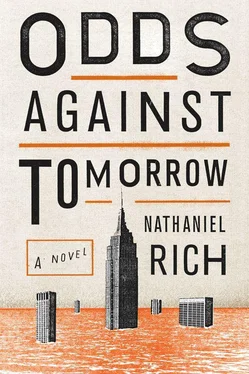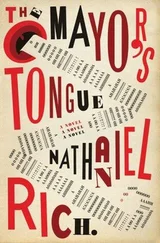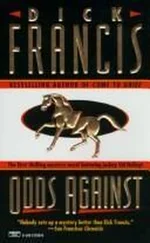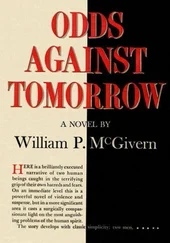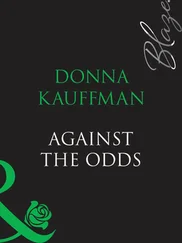It had slowed to a drizzle by the time he headed for the subway the next morning, but the city had been noticeably altered. The sewer grates were clogged with crushed plastic bags, creating muddy ponds that gathered around each street corner. The sidewalk smelled of fresh soil. The exultant mood had already given way, overnight, to one of fatigued irascibility. It was typical New York City, this whiplash effect, one day’s exuberance followed the next day by a hangover and the shakes. The sudden rains had overwhelmed many of the city’s basic operations. Underground, Mitchell took his place behind a mob of exasperated commuters standing five-deep back from the tracks. A voice over the loudspeaker reported in a mechanical, stroboscopic bellow that several downtown stations had been closed due to flooding. A man next to him was so furious that he burst into tears.
He blamed himself for not anticipating this sooner. Then he blamed Elsa. Her mystic optimism had brainwashed him into seeing his work as just, well, work. But it wasn’t just work. It was life and death. He had been completely disengaged, zombified. On the previous afternoon he had returned to the library and examined the city’s basic water blueprint. What he found haunted him.
In the days when Times Square was a red maple swamp and St. Mark’s Place a hickory forest populated by hawks and ravens, more than forty brooks and streams covered the island of Manhattan. During high tide, the Lenape Indians could canoe from the East River straight through to the Hudson River across what is now Canal Street. His old office at Fitzsimmons Sherman stood over a little body of water called Sunfish Pond, which was beloved by early settlers for its profusion of sunfish, flounder, and eels. For all he knew, the pond was still there beneath the Empire State Building, percolating below the subbasement, the sunfish and flounder gone, but perhaps not the eels.
All of these waterways were buried when the city was built in the eighteenth and nineteenth centuries, but the water didn’t disappear — it still pumped through the undersoil. Even during a drought Manhattan’s natural water table gushed thirteen million gallons of groundwater into the subway tunnels daily — water that once had been absorbed by roots, marshes, and streams. Every day, eight hundred electric-powered municipal pumps diverted the excess water into the sewer system. Whenever a sizable storm hit, the pumps were overtaxed and the subway tunnels flooded. After just twenty minutes of rain, Brooklyn’s sewage pipes began to overflow and human excrement spilled into the Upper New York Bay, Gowanus Canal, and Newton Creek. This was the price of having the entire island overlaid by concrete and a subway system buried deep in the earth — below the sewer pipes. The underground city was a water balloon filled to bursting. It just needed one sharp poke.
When he called the office, Tewilliger picked up before the first ring finished chiming. Charnoble had trained her well.
“Future.”
“It’s Mitchell. I’m going to be a little late this morning—”
“No, you’re not.”
“Excuse me?”
“Hold.”
The hold music came on the line. It was a pop song from around the turn of the century, set against plaintive piano chords:
As logic stands,
you couldn’t meet a man
who’s from the future.
But logic broke,
as he appeared he spoke
about the future.
We’re not going to make it …
The song had been Jane’s idea. She screamed with laughter every time she was put on hold. It was starting to get under Mitchell’s skin.
“Zukor!” Charnoble came on the line. He had never addressed Mitchell as Zukor before. He was out of breath.
“Alec. What’s happening?”
“We need you here now. The phone is ringing off the hook, in a manner of speaking. This may be our first live disaster.”
The excitement in his voice was extreme, bordering on grotesque. Charnoble explained that Tammy had been upgraded to a Category 2 hurricane, gusts as high as 105 miles per hour.
“You should see the Doppler,” said Charnoble, and Mitchell could picture the spittle on his lips. “Overnight the beast spun into a tight spiral.”
“Where is it going to make landfall? Is it coming here?”
“Too early to tell. Weather Channel says Chesapeake Bay. CNN is reporting the Delaware coast. But Big Henry D. thinks farther east, near Ocean City.”
“Ocean City would be very bad,” said Mitchell. “But Atlantic City — Atlantic City would be catastrophic.”
“Let’s pray for Atlantic City!”
Mitchell didn’t bother to explain that a storm passing through Atlantic City would likely head straight to Manhattan. He worried that this information would only multiply Charnoble’s giddiness. Instead he asked Charnoble to pull out his hurricane files so that Jane could review them before her meetings. The first file was a collection of material about the 1821 storm, one of the only hurricanes to have passed directly over Manhattan. During that storm the tide rose thirteen feet in a single hour, causing the East River to meet the Hudson in what is now SoHo.
Charnoble had already booked both of them through the day. Mitchell volunteered to go straight to his first appointment. He was up-to-date on the literature now, he didn’t need his notes. The client was Jason Tanizaki, a vice-president of Lady Madeline, the perfume giant. Lady Madeline was concerned about what damage a hurricane might cause to their scent-production factory in Middlesex County, less than a mile from the ocean.
It seemed easier to work than to think of everything that might happen. Work, his old savior, would clear his brain, or at least distract him. It had been the same thing his whole life: when the hot panics came, he turned to math for relief. During high school he had seen an episode of Mega Disasters about the massive volcano, larger than the state of Rhode Island, that lay beneath Yellowstone National Park. The Yellowstone volcano had erupted three times. Each time it had covered the western half of North America with a foot of volcanic ash. Winds carried sulfur aerosols and ash particles around the entire planet, causing temperatures to plummet. Nearly all life on earth went extinct. The volcano erupted roughly every six or seven hundred thousand years; the last eruption had occurred 640,000 years ago. It seemed that we were due. With a shaky hand Mitchell had turned off the television. The host of Mega Disasters —a bearded man best known for hosting a dating show — had said that the volcano had erupted 2.1 million years ago, 1.3 million years ago, and.64 million years ago. Mitchell wrote the figures on a pad and took out a calculator. If you added the intervals between eruptions and divided by three, that meant the Yellowstone volcano’s average dormancy period was 730,000 years. After plotting a probability graph, he determined that the chance another massive eruption would occur in the next one hundred years was 0.00055 percent, or 1 in 181,000. An exceedingly low number, one that did not justify the ominous tone used by Mr. Megadisasters. Those zeroes on the LCD face of his TI-89 calculator had made all the difference. They were like little white pills that faded out his anxiety. They put him to sleep.
But the information he had found at the library, reading about Manhattan’s full bladder, had not yielded anything that suggested he was overreacting. And with the schedule of meetings today, there would be no time to call the top people at the local universities: the hydrologists, fluviologists, geomorphologists — anyone, really, who could tell him what the future would cost him.
The Lady Madeline Tower was only five blocks away, so he abandoned the crowded subway station and set off on a sprint, his eyes turned upward, not caring where his feet landed. The gray clouds had sapped the coloration of the skyscrapers; every glass, stone, and steel surface had the same dull slate hue. It was as if Manhattan were assuming the qualities of his skycity — it lacked only the brilliant cobalt-blue sky of his dreams. When he reached the office building he was panting. A dismayed security guard stared pointedly at his shoes. They were leaking black dye onto the expensive carpet. He might as well have been walking on ink pads.
Читать дальше
